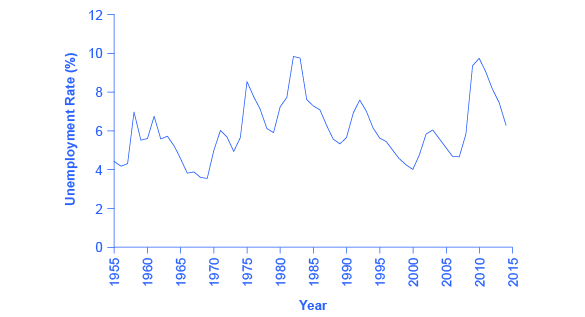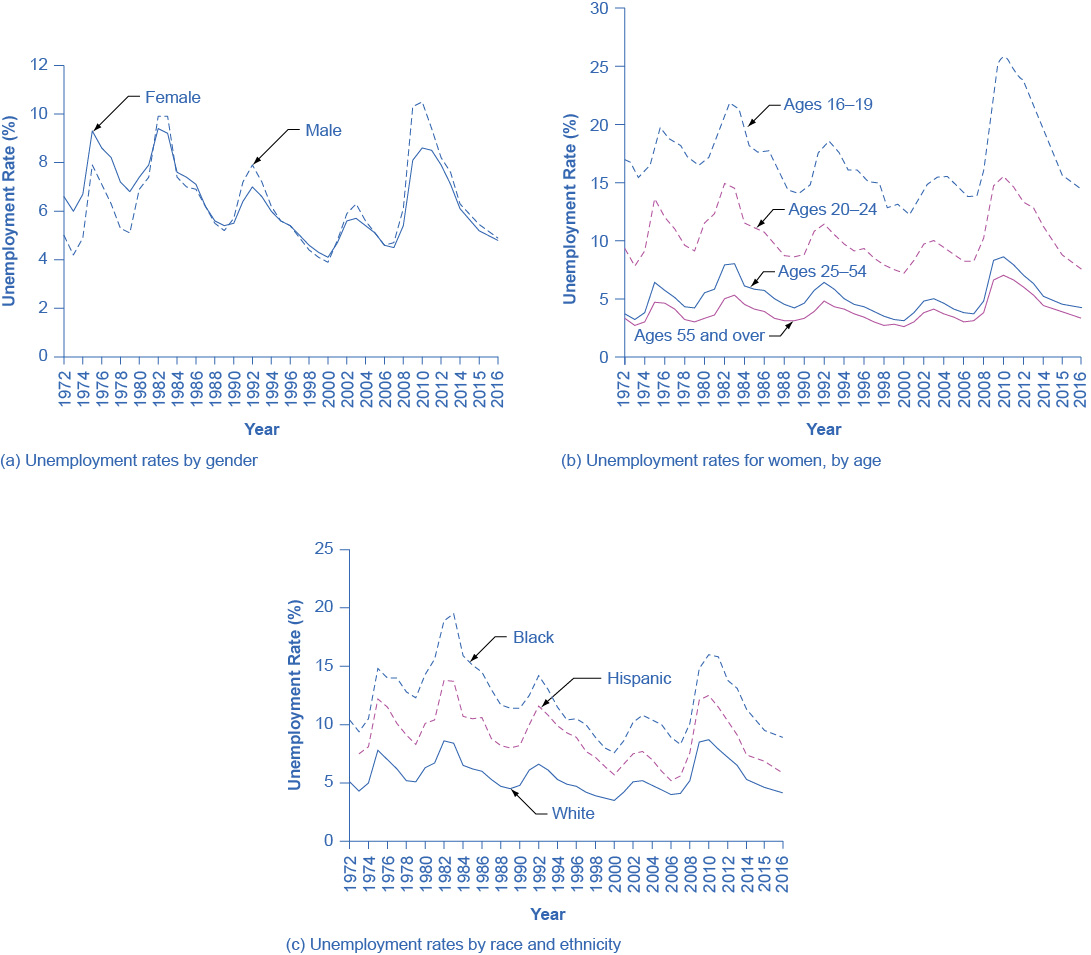Part 21: Unemployment
21.2 Patterns of Unemployment
Learning Objectives
By the end of this section, you will be able to:
- Explain historical patterns of unemployment in the U.S.
- Identify trends of unemployment based on demographics
- Evaluate global unemployment rates
Let’s look at how unemployment rates have changed over time and how various groups of people are affected by unemployment differently.
The Historical U.S. Unemployment Rate
(Figure) shows the historical pattern of U.S. unemployment since 1955.

As we look at this data, several patterns stand out:
- Unemployment rates do fluctuate over time. During the deep recessions of the early 1980s and of 2007–2009, unemployment reached roughly 10%. For comparison, during the 1930s Great Depression, the unemployment rate reached almost 25% of the labor force.
- Unemployment rates in the late 1990s and into the mid-2000s were rather low by historical standards. The unemployment rate was below 5% from 1997 to 2000, and near 5% during almost all of 2006–2007, and 5% or slightly less from September 2015 through January 2017 (the latest date for which data are available as of this writing). The previous time unemployment had been less than 5% for three consecutive years was three decades earlier, from 1968 to 1970.
- The unemployment rate never falls all the way to zero. It almost never seems to get below 3%—and it stays that low only for very short periods. (We discuss reasons why this is the case later in this chapter.)
- The timing of rises and falls in unemployment matches fairly well with the timing of upswings and downswings in the overall economy, except that unemployment tends to lag changes in economic activity, and especially so during upswings of the economy following a recession. During periods of recession and depression, unemployment is high. During periods of economic growth, unemployment tends to be lower.
- No significant upward or downward trend in unemployment rates is apparent. This point is especially worth noting because the U.S. population more than quadrupled from 76 million in 1900 to over 324 million by 2017. Moreover, a higher proportion of U.S. adults are now in the paid workforce, because women have entered the paid labor force in significant numbers in recent decades. Women comprised 18% of the paid workforce in 1900 and nearly half of the paid workforce in 2017. However, despite the increased number of workers, as well as other economic events like globalization and the continuous invention of new technologies, the economy has provided jobs without causing any long-term upward or downward trend in unemployment rates.
Unemployment Rates by Group
Unemployment is not distributed evenly across the U.S. population. (Figure) shows unemployment rates broken down in various ways: by gender, age, and race/ethnicity.

The unemployment rate for women had historically tended to be higher than the unemployment rate for men, perhaps reflecting the historical pattern that women were seen as “secondary” earners. By about 1980, however, the unemployment rate for women was essentially the same as that for men, as (Figure) (a) shows. During the 2008-2009 recession and in the immediate aftermath, the unemployment rate for men exceeded the unemployment rate for women. Subsequently, however, the gap has narrowed.
Read this report for detailed information on the 2008–2009 recession. It also provides some very useful information on the statistics of unemployment.
Younger workers tend to have higher unemployment, while middle-aged workers tend to have lower unemployment, probably because the middle-aged workers feel the responsibility of needing to have a job more heavily. Younger workers move in and out of jobs more than middle-aged workers, as part of the process of matching of workers and jobs, and this contributes to their higher unemployment rates. In addition, middle-aged workers are more likely to feel the responsibility of needing to have a job more heavily. Elderly workers have extremely low rates of unemployment, because those who do not have jobs often exit the labor force by retiring, and thus are not counted in the unemployment statistics. (Figure) (b) shows unemployment rates for women divided by age. The pattern for men is similar.
The unemployment rate for African-Americans is substantially higher than the rate for other racial or ethnic groups, a fact that surely reflects, to some extent, a pattern of discrimination that has constrained blacks’ labor market opportunities. However, the gaps between unemployment rates for whites and for blacks and Hispanics diminished in the 1990s, as (Figure) (c) shows. In fact, unemployment rates for blacks and Hispanics were at the lowest levels for several decades in the mid-2000s before rising during the recent Great Recession.
Finally, those with less education typically suffer higher unemployment. In January 2017, for example, the unemployment rate for those with a college degree was 2.5%; for those with some college but not a four year degree, the unemployment rate was 3.8%; for high school graduates with no additional degree, the unemployment rate was 5.3%; and for those without a high school diploma, the unemployment rate was 7.7%. This pattern arises because additional education typically offers better connections to the labor market and higher demand. With less attractive labor market opportunities for low-skilled workers compared to the opportunities for the more highly-skilled, including lower pay, low-skilled workers may be less motivated to find jobs.
Breaking Down Unemployment in Other Ways
The Bureau of Labor Statistics also gives information about the reasons for unemployment, as well as the length of time individuals have been unemployed. (Figure), for example, shows the four reasons for unemployment and the percentages of the currently unemployed that fall into each category. (Figure) shows the length of unemployment. For both of these, the data is from January 2017.(bls.gov)
| Reason | Percentage |
|---|---|
| New Entrants | 10.8% |
| Re-entrants | 28.7% |
| Job Leavers | 11.4% |
| Job Losers: Temporary | 14.0% |
| Job Losers: Non Temporary | 35.1% |
| Length of Time | Percentage |
|---|---|
| Under 5 weeks | 32.5% |
| 5 to 14 weeks | 27.5% |
| 15 to 26 weeks | 15.7% |
| Over 27 weeks | 27.4% |
Watch this speech on the impact of droids on the labor market.
International Unemployment Comparisons
From an international perspective, the U.S. unemployment rate typically has looked a little better than average. (Figure) compares unemployment rates for 1991, 1996, 2001, 2006 (just before the recession), and 2012 (somewhat after the recession) from several other high-income countries.
| Country | 1991 | 1996 | 2001 | 2006 | 2012 |
|---|---|---|---|---|---|
| United States | 6.8% | 5.4% | 4.8% | 4.4% | 8.1% |
| Canada | 9.8% | 8.8% | 6.4% | 6.2% | 6.3% |
| Japan | 2.1% | 3.4% | 5.1% | 4.5% | 3.9% |
| France | 9.5% | 12.5% | 8.7% | 10.1% | 10.0% |
| Germany | 5.6% | 9.0% | 8.9% | 9.8% | 5.5% |
| Italy | 6.9% | 11.7% | 9.6% | 7.8% | 10.8% |
| Sweden | 3.1% | 9.9% | 5.0% | 5.2% | 7.9% |
| United Kingdom | 8.8% | 8.1% | 5.1% | 5.5% | 8.0% |
However, we need to treat cross-country comparisons of unemployment rates with care, because each country has slightly different definitions of unemployment, survey tools for measuring unemployment, and also different labor markets. For example, Japan’s unemployment rates appear quite low, but Japan’s economy has been mired in slow growth and recession since the late 1980s, and Japan’s unemployment rate probably paints too rosy a picture of its labor market. In Japan, workers who lose their jobs are often quick to exit the labor force and not look for a new job, in which case they are not counted as unemployed. In addition, Japanese firms are often quite reluctant to fire workers, and so firms have substantial numbers of workers who are on reduced hours or officially employed, but doing very little. We can view this Japanese pattern as an unusual method for society to provide support for the unemployed, rather than a sign of a healthy economy.
We hear about the Chinese economy in the news all the time. The value of the Chinese yuan in comparison to the U.S. dollar is likely to be part of the nightly business report, so why is the Chinese economy not included in this discussion of international unemployment? The lack of reliable statistics is the reason. This article explains why.
Comparing unemployment rates in the United States and other high-income economies with unemployment rates in Latin America, Africa, Eastern Europe, and Asia is very difficult. One reason is that the statistical agencies in many poorer countries lack the resources and technical capabilities of the U.S. Bureau of the Census. However, a more difficult problem with international comparisons is that in many low-income countries, most workers are not involved in the labor market through an employer who pays them regularly. Instead, workers in these countries are engaged in short-term work, subsistence activities, and barter. Moreover, the effect of unemployment is very different in high-income and low-income countries. Unemployed workers in the developed economies have access to various government programs like unemployment insurance, welfare, and food stamps. Such programs may barely exist in poorer countries. Although unemployment is a serious problem in many low-income countries, it manifests itself in a different way than in high-income countries.
Key Concepts and Summary
The U.S. unemployment rate rises during periods of recession and depression, but falls back to the range of 4% to 6% when the economy is strong. The unemployment rate never falls to zero. Despite enormous growth in the size of the U.S. population and labor force in the twentieth century, along with other major trends like globalization and new technology, the unemployment rate shows no long-term rising trend.
Unemployment rates differ by group: higher for African-Americans and Hispanics than for whites; higher for less educated than more educated; higher for the young than the middle-aged. Women’s unemployment rates used to be higher than men’s, but in recent years men’s and women’s unemployment rates have been very similar. In recent years, unemployment rates in the United States have compared favorably with unemployment rates in most other high-income economies.
Self-Check Questions
Over the long term, has the U.S. unemployment rate generally trended up, trended down, or remained at basically the same level?
Over the long term, the U.S. unemployment rate has remained basically the same level.
Whose unemployment rates are commonly higher in the U.S. economy:
- Whites or nonwhites?
- The young or the middle-aged?
- College graduates or high school graduates?
- Nonwhites
- The young
- High school graduates
Review Questions
Are U.S. unemployment rates typically higher, lower, or about the same as unemployment rates in other high-income countries?
Are U.S. unemployment rates distributed evenly across the population?
Critical Thinking Questions
Is the higher unemployment rates for minority workers necessarily an indication of discrimination? What could be some other reasons for the higher unemployment rate?
While unemployment is highly negatively correlated with the level of economic activity, in the real world it responds with a lag. In other words, firms do not immediately lay off workers in response to a sales decline. They wait a while before responding. Similarly, firms do not immediately hire workers when sales pick up. What do you think accounts for the lag in response time?
Why do you think that unemployment rates are lower for individuals with more education?

